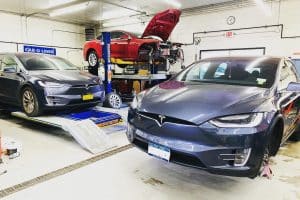- 🚗 General Motors plans to cut over 1,000 jobs in its software division to streamline operations.
- 🛠️ The layoffs include approximately 600 employees at GM’s Global Technical Center in Warren, Michigan.
- 🏢 GM is optimizing organizational structures by flattening hierarchies to focus on high-priority projects.
- 📈 The company aims to generate around $25 billion in revenue from software and services by 2030.
- 🚀 GM is also focusing on its electric vehicle initiatives and its driverless ride-hailing subsidiary, Cruise.
- 👉 GM has not commented on how the cuts will directly impact its EV and software plans for the year.
The Scope of GM’s Software Division Layoffs
General Motors’ decision to cut over 1,000 jobs within its software division aligns with its strategic objective to “simplify organization” and foster growth in high-priority areas. Of these, approximately 600 positions will be eliminated at GM’s Global Technical Center located in Warren, Michigan. This measure signifies a significant restructuring effort aimed at optimizing operational frameworks for improved efficiency and speed.
The Rationale Behind the Move
GM’s restructuring reflects a necessity to adapt rapidly to market changes and technological advancements. The company stated that these layoffs are part of a carefully considered strategy to downsize hierarchies and mitigate redundancies. By shifting resources towards pivotal projects, GM aspires to stay ahead in a competitive market landscape while balancing its workforce needs.
GM executives emphasized the need for decisive action to enable quicker business decisions and fuel innovation—an approach crucial for navigating the digital transformation wave sweeping across industries. As electrical and autonomous vehicles reshape the automotive domain, GM is strategically positioning itself to harness these disruptions’ potential benefits.
Financial and Strategic Implications
GM aims to generate approximately $25 billion in revenue from software and services by 2030, marking a significant orientational shift towards software-driven revenue streams. This ambitious target underscores the importance of maximizing efficiency and focusing on areas that offer the greatest growth potential.
Impacts on EV and Autonomous Vehicle Strategies
While GM has yet to comment explicitly on how these job cuts will impact its broader EV and software plans for the year, the company is evidently doubling down on its electric vehicle and driverless ride-hailing endeavors. Through its subsidiary, Cruise, GM continues to push boundaries in creating autonomous ride-sharing services. Although currently not generating revenue due to regulatory setbacks, Cruise is expected to relaunch with paid services soon, reinforcing GM’s mobile innovation commitments.
Anticipated Outcomes and Industry Trends
For companies like GM, the decision to condense software operations reflects a broader industry trend where businesses focus intently on trimming costs while propelling digital and electrified vehicle advancements. By prioritizing software and technology investments, GM shores up its position as a future-driven automotive leader.
Building robust and agile operational and technological frameworks becomes invaluable as automakers navigate shifting regulatory landscapes and consumer expectations. GM’s restructured approach mirrors an industry increasingly characterized by electrification, connectivity, and autonomous vehicle technologies.
Key Takeaways
- GM’s job cuts reinforce the shift towards technology-driven business models and electrification strategies.
- Restructuring is aimed at flattening organizational structures to prioritize high-impact projects and fast-track decision-making.
- The goal of a $25 billion revenue milestone by 2030 highlights the company’s commitment to leveraging software as a core business component.
- Progress in autonomous driving solutions, notably through the Cruise subsidiary, remains central to GM’s long-term strategy.
This transformative phase underscores GM’s resolve to innovate in a rapidly evolving industry landscape, encouraging automakers to balance efficiency with strategic investment in next-generation mobility services.





